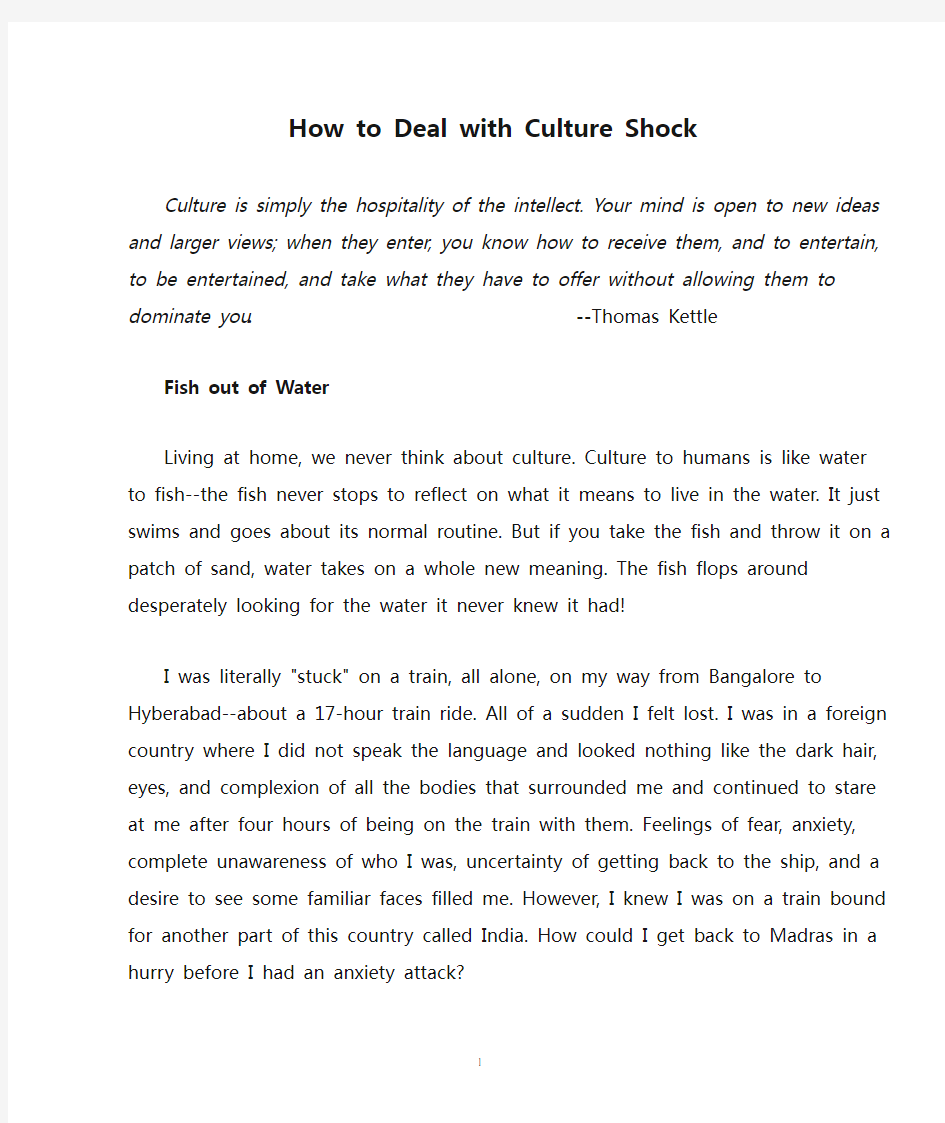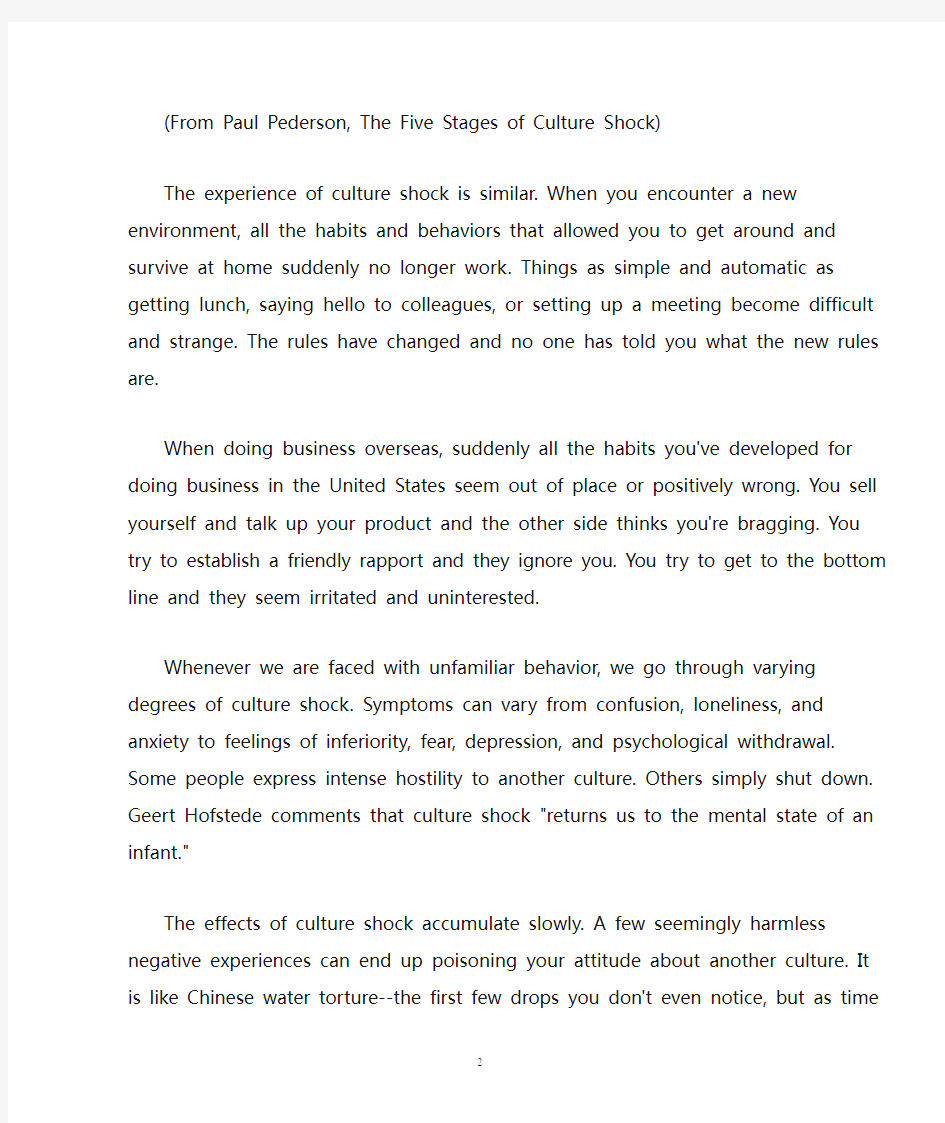How to Deal with Culture Shock


How to Deal with Culture Shock
Culture is simply the hospitality of the intellect. Your mind is open to new ideas and larger views; when they enter, you know how to receive them, and to entertain, to be entertained, and take what they have to offer without allowing them to dominate you.
--Thomas Kettle
Fish out of Water
Living at home, we never think about culture. Culture to humans is like water to fish--the fish never stops to reflect on what it means to live in the water. It just swims and goes about its normal routine. But if you take the fish and throw it on a patch of sand, water takes on a whole new meaning. The fish flops around desperately looking for the water it never knew it had!
I was literally "stuck" on a train, all alone, on my way from Bangalore to Hyberabad--about a 17-hour train ride. All of a sudden I felt lost.
I was in a foreign country where I did not speak the language and looked nothing like the dark hair, eyes, and complexion of all the bodies that surrounded me and continued to stare at me after four hours of being on the train with them. Feelings of fear, anxiety, complete unawareness of who I was, uncertainty of getting back to the ship, and a desire to see some familiar faces filled me. However, I knew I was on a train bound for another part of this country called India. How could I get back to Madras in a hurry before I had an anxiety attack?
(From Paul Pederson, The Five Stages of Culture Shock)
The experience of culture shock is similar. When you encounter a new environment, all the habits and behaviors that allowed you to get around and survive at home suddenly no longer work. Things as simple and automatic as getting lunch, saying hello to colleagues, or setting up a meeting become difficult and strange. The rules have changed and no one has told you what the new rules are.
When doing business overseas, suddenly all the habits you've developed for doing business in the United States seem out of place or positively wrong. You sell yourself and talk up your product and the other side thinks you're bragging. You try to establish a friendly rapport and they ignore you. You try to get to the bottom line and they seem irritated and uninterested.
Whenever we are faced with unfamiliar behavior, we go through varying degrees of culture shock. Symptoms can vary from confusion, loneliness, and anxiety to feelings of inferiority, fear, depression, and psychological withdrawal. Some people express intense hostility to another culture. Others simply shut down. Geert Hofstede comments that
culture shock "returns us to the mental state of an infant."
The effects of culture shock accumulate slowly. A few seemingly harmless negative experiences can end up poisoning your attitude about another culture. It is like Chinese water torture--the first few drops you don't even notice, but as time goes on the drip, drip, drip can drive you crazy.
Hostility, anxiety, or depression can affect a person's judgment and ability to communicate during delicate negotiations. Managerial duties can become a daily encounter with the enemy. Culture shock is a leading cause of early repatriations that can be quite costly for the company. The experience can be especially difficult for spouses or children who come along on overseas assignments. Without a job to give them direction and a stable point of contact with the other culture, they can feel lost and helpless.
The Stages of Cultural Adjustment
In Cultures and Organizations, Hofstede describes the stages one goes through while adjusting to another country. The first stage involves a romance with the surface features of a culture. Everything is new, different, and exciting, and feelings for the new culture are very positive. Most tourists and many short-term business travelers experience other cultures in stage one. The second stage of adjusting to another culture is culture shock, when the lack of familiar reference points and behavioral norms leads to overload and withdrawal. Feelings for the new culture become very negative. This stage often arrives for expatriates or business travelers after the initial greetings and ceremonies are over and they find they have to survive in a new culture on their own without being treated as the honored guest any longer. Culture shock can vary dramatically from person to person or situation to situation. One person can experience severe culture shock in a situation that would barely affect another. Some people barely experience culture shock on one trip and are affected severely on the next.
The third stage is a gradual period of acculturation during which the visitor learns to operate according to the norms and values of the other culture. This period requires work; learning about another culture means getting out and interacting in a meaningful way with other people in social and work settings.
The fourth and final stage is the arrival at a stable state of mind that marks the level of adjustment to the other culture. This stable state can remain negative (the person feels more or less permanently alienated), neutral (a good healthy bicultural ability), or positive (the person "goes native").
What Can Be Done to Deal with Culture Shock?
The best defense against culture shock is knowledge of how other cultures operate. In Culture Shock: Psychological Reactions to Unfamiliar Environments, Adrian Furnham and Stephen Bochner point out that culture shock is not a psychological disorder but a lack of social skills and knowledge needed to deal with a new environment. Even if things seem alien and disorienting, knowing some of the rules gives us reference points and a degree of confidence. One of the best ways to deal with culture shock is to look at the experience as an opportunity to learn--not only about the other side's culture, but also about specific factors that will influence doing business with them. Dealing with other cultures is a skill we can acquire.
The amount of time required for acculturation and how well you have adjusted at the end of the process depend largely on attitude and effort. Younger people generally have an easier time adjusting to new cultures and situations because they haven't formed a rigid framework for looking at the world and how things should be done. Adults who are set in their ways are more likely to see things that are different as deficient or threatening.
Approaching new ways of doing things with openness and curiosity can change the whole experience of being in another culture. It helps to remind yourself periodically to maintain a positive attitude and try things with an open mind. We often respond automatically to things that are different. It is possible to build up negative feelings about other cultures without being aware of it.
I had never heard of Libya before being stationed in Tripoli. About two weeks after I arrived in the country, Muhammar al-Khadafy overthrew the king in a military coup. I was assigned to work with a group of advisers to help the Libyans with their young air force. One of the first things I noticed was a strange physical feature: Many of the men had one bad eye. After some questioning, I discovered that the men had had their eyes damaged by their mothers as a way to keep them out of military service during the period when the Italians ruled the country.
Another thing that looks getting used to was the way women onlyshowed themselves in public completely covered except for one eye. When we went to visit the house of one of the Libyans we worked with, his mother brought the food to the door of the room and handed it to him without entering. We never did see her.
Later I saw the same man looking very depressed and asked what was wrong. He told me that he was getting married. This didn't seem like a reason to be depressed, until he told me that it was an arranged marriage and that he had a girlfriend he loved very much.
--Louis Krindelbaugh
The degree of culture shock you experience does not necessarily depend on how long you've been in another country. You don't absorb other cultures through osmosis. Going out to eat in local restaurants and buying souvenirs isn't enough. You have to get out and spend time with local people and learn about their perspective.
There are immigrants who have lived in the United States for 40 years and still experience culture shock. They've brought their own culture with them; they shop in their own grocery stores and hang out with their own people. The same thing can happen to Americans overseas. You can be in a foreign country for years, but if you spend all your time with other Americans and don't interact with the native culture, you might never get over culture shock.
I interviewed a woman who had accompanied her husband on an overseas assignment to Poland. She was struck by the way American lived in expatriate ghettos where they stuck with each other and had nothing to do with the local culture.
Associating only with your own compatriots is a sure sign of culture shock. It indicates that you are seeking the comfort of the known and the familiar rather than confronting and learning about differences. Really to adjust to a new culture you need to create a new framework for understanding the world. It might not be your framework, but unless you can learn to use it, you'll always be on the outside.
(1615 words)
如何培养英语跨文化交际能力
如何培养英语跨文化交际能力 中宁五中张永宏 摘要:本文通过分析我国英语教学现状,探索英语教学中培养跨文化交际能力的必要性,具体分析“跨文化交际能力”的三大组成,思考培养英语跨文化交际能力的具体方法。 关键词:跨文化交际语义文化语用文化 多年来,我国的英语教学主要采用传统的教学方法,即传统的听说法“with its end less and mind-numbing repetitive drills”和古老的以教师为中心的语法—翻译法。教师往往只注重学生语言形式的正确与否或使用是否流畅,而较少注重结合语言使用的场合来培养学生综合运用的能力。学生在这种教学模式下,经过十几年的英语学习,即使是有些成绩很好的学生也不能用所学的英语同外国人进行有效地交流。为了改变这种现状,人们必然对英语教学提出新的要求。而跨文化交际能力的培养却能在一定程度上弥补传统教学的这种缺陷。 首先,何为跨文化交际呢?“跨文化交际”的英语名称是“intercultural communication”或“cross-cultural communication”,它既指本族语者与非本族语者之间的交际,也指任何在语言和社会文化背景方面有差异的人们之间的交际。由于不同的民族所处的生态、物质社会及宗教等环境的不同,因而各自的语言环境产生了不同的社会文化、风土人情和语言习惯等诸语境因素,造成人们不同的说话方式或习惯话语。这就可能使交际双方对对方的话语做出不准确地推论,从而产生冲突、误会或交际的故障。 跨文化交际能力就是针对文化冲突提出来的,它是一种在理解、掌握外国文化知识与交际技能的基础上,灵活处理跨文化交际中出现的实际问题的能力。 一、英语教学中培养跨文化交际能力的必要性。 1、近年来, 随着改革开放步伐的加快, 对外交往日益频繁, 国与国之间的交流也越来越 广泛, 特别是社会信息化提高, 国际互联网的开通使更多的人足不出户便涉及到跨 文化交际。中国成功地加入WTO后,国际市场对能用英语熟练有效地交际的复合型人才的大量需求给外语教学提出了新的挑战,所以培养跨文化交际能力有其现实意义。 2、培养跨文化交际能力有助于我们要打破以往“就语言教语言”的模式,把交际因素引 进到英语教学中来,在英语教学过程中揭示那些隐伏在语言背后的,易引起误会和冲突的文化因素。掌握语言不只是掌握语法、音位和语义规则,还必须考虑到外国社会文化背景造成的语言之外的规则。 3、培养跨文化交际能力有利于处理好语言和文化的关系。语言和文化是不可分割的,二 者相互依存、相互影响。语言是文化的载体,又是文化的重要组成部分,也是文化的
大学生跨文化交际能力的培养
大学生跨文化交际能力的培养 摘要:当前大学英语教学的重要目标是培养学生跨文化交际能力,我国频繁的对外交流,需要高素质的跨文化交际能力人才。文章根据跨文化交际能力的内涵和概念,从理论的层次探讨了跨文化交际能力的培养方式 关键词:跨文化交际能力; 英语 Abstract:Current college English teaching important goal is to develop students' intercultural communicative competence, our frequent international exchanges, high-quality intercultural communicative competence talent.According to the content and concepts of intercultural communicative competence, from the theoretical level of Intercultural Communication ability Key words: cross-cultural communication skills; English teaching 随着全球化的发展,世界各国之间的跨文化交际成为不可避免的趋势。改革开放的不断深入,中国的对外交流活动也已经涉及到政治,经济,文化,教育和旅游等各个领域。然而由于各国之间的文化差异,交流不可避免会产生误会,如何与不同文化背景的人进行交流,成为了一个亟待解决的问题。 一、跨文化交际能力相关涵义 与跨文化交际能力相关的涵义涉及到文化,交际还有能力等层面,交际和交际能力是其基础。英语中的“交际”,也就是“communication”,来源于拉丁语“commonis”一词,意思是“共同”“共享”,信息的交换和传达等。Lusting &Koester( 1996) 认为交际是人们通过符号来创造共享意义的过程。关世杰( 1995) 将交际定义为“信息发送者与信息接受者共享信息的过程”。根据现代交际学范畴,交际是人们相互沟通信息的过程,也就是人们运用语言或者非语言信息传达思想和表达感情的交流过程。交际能力( communicative competence)由Hymes 提出,指的是有着具体文化身份的说话者和某一客观存在的言语群体进行恰当交流所必须要掌握的一切知识和技能。文化和交际有所不同,其概念难以界定,早在
跨文化交际能力的培养
跨文化交际能力的培养 摘要:由于汉英文化存在着截然不同的传统和风俗习惯,人们的生活方式、思维方式、价值观念、语言习惯等都有很大的差别,许多日常行为在两种语言的交际活动中也存在明显的文化差异。语言只有在一定的文化背景下及语境中被正确使用,才能体现出它的交际价值。因此,英语教学应加强跨文化意识和交际模式的培养,相应的引入文化教学,使语言知识与语用规则有机结合,以培养学生的跨文化语用能力。 关键词:跨文化交际中西文化差异文化教学 1 跨文化交际中语言与文化的关系 “跨文化交际”是指具有不同文化背景的人们之间进行的交际。要想有效的培养跨文化交际能力,首先要明确语言和文化的关系。 语言是文化的载体,是文化的一个密不可分的组成部分,它既反映文化,也受文化的影响。外语学习的目的是为了交际,而交际就不可避免地要受到社会文化的制约。随着对外开放程度的逐渐深入,西方的人和事物越来越多的走进了我们的视野,不同文化背景的人们彼此间的交往日益频繁。各种文化在接触和碰撞中相互影响、相互渗透、相互吸收、相互融合,必定会影响跨文化交流,用英语成功地进行跨文化交际不仅仅需要单纯的语言能力,还需要了解英语国家的文化,否则,在实际的交际过程中,就会出现由于文化差异而造成的场景不合适或者不得体的语言失误,引起误会。因此,我们有必要研究语言中的文化因素,以消除跨文化交际中因文化差异而导致的语用障碍。 对于普通高校英语专业的学生来说,如何在英语语言教学中渗透西方文化,使中西文化交流和语言交流相辅相成就变得尤为重要。 2 中西跨文化交际中经常出现的文化差异 在中西跨文化交际中会出现的文化差异有很多种,在这里我们不可能一一叙述,只能列出比较常见的几种。 (1)隐私方面的差异。中国人的隐私观念比较薄弱,认为个人要归属于集体,在一起讲究团结 友爱,互相关心,因而中国人往往很愿意了解别人的酸甜苦辣,对方也愿意坦诚相告。而西方人
跨文化交际能力及其培养 一种建构主义的观点
作者简介:刘学惠(1956-),副教授,硕士,研究方向:应用语言学与外语教育学收稿日期:2002-07-11 2003年第1期 总第166期 外语与外语教学 F oreign Languages and Their T eaching 2003,№1Serial №166 跨文化交际能力及其培养:一种建构主义的观点 刘学惠 (南京师范大学外国语学院,江苏南京 210097) 摘 要:本文从建构主义观点出发,分析了跨文化交际能力的构成———不但有知识的成分,还有思维能力和行为能力 的成分;提出了培养上述能力的显性和隐性两种教学路径并考察了若干实践层面的问题。 关键词:跨文化交际,外语教学,建构主义,显性学习与隐性学习 Abstract :From the constructivist perspective ,intercultural communication competence contains not only knowledge about existing cul 2tural facts ,but also abilities of interpreting and coping with on 2going intercultural events.T o develop such competence ,it is proposed that an explicit approach and an implicit approach be combined and innovations be made in teaching materials and methods. K ey words :intercultural communication ,foreign language teaching ,constructivism ,explicit learning and implicit learning 中图分类号:H319 文献标识码:A 文章编号:1004-6038(2003)01-0034-03 1.引言 跨文化交际的话题近年来在外语教学界倍受关注,然而 需要深入思考的是:什么是我们所寻求的跨文化交际能力?这种能力有何种构成要素?它们通过什么途径而获得?从国内现有文献看,认识似乎尚局限在这样的范围,即外语学习者应具有有关目的语文化的知识;外语教学应加强对这些知识的传授或导入。本文尝试用另一种思考角度———一种建构主义的观点,探讨上述问题,意在增进认识和促进跨文化交际教育的发展。 建构主义(constructivism )是当代认知心理学的一个重要理论。其要义是:世界虽然是客观存在的,但人们对于世界的理解和赋予意义是主观的;知识不可能由外部传授而获得,人们应以自己的经验背景为基础来建构现实和理解现实,从而形成知识;学习是学习者主动地建构内部心理表征的过程,这种建构不仅涉及结构性的知识,而且涉及大量非结构性的知识(Duffy &Jonason ,1991,引自张建伟、陈琦,1996)。这种观点对于我们认清跨文化交际能力的本质和构建跨文化交际能力的的培养模式具有重要的启示意义。 2.跨文化交际能力的涵义 跨文化交际能力是一个综合的、多向度(multi 2dimension 2al )的概念:除知识向度外,还有思维向度、行为向度乃至情感和个性向度。 跨文化交际能力的多向度性与“文化”极为宽泛的涵义及表现形式有关。文化是社会的精神生活和物质生活的总称。因此,它既是业已存在和经历积淀的,又是尚在发生和流动变化的;它有外显的和可以客观描述的一面,又有隐蔽的和依赖主观解释的一面;它既具有组织的、群体的性质,又无不渗透到每个具有个人特点的具体行为之中;它既表现为高级智力活动的过程与产物,又体现在一般人最普通的生活方式和行为之中。这些对应的现象即所谓“大写”的文化(C )和“小写”的文化(c )(Brooks ,1960,Allen ,1985,引自Chen ,1999)。在理解跨文化交际能力的时候,如果人们只强调文化既有的、外显的、客观的和组织的一面,教学中则倾向于突出跨文化能力中的“知识”向度,在考虑教学内容和方法时则倾向于传授既有的文化事实,如目的语民族的历史发展、社会制度、一般习俗、礼仪、禁忌等。这种文化教学从总体上看是直接的、外显的和由外部施加的,甚至是可以独立或相对独立于语言教学的。 令人深思的是,在外语学习者经直接传授获得了有关文化的客观知识后,当他面临具体的跨文化交际情境时,那些概括化、刻板化(sterotyped )了的文化特征、行为规范等往往并不能保证他交际的成功。显然,真实的跨文化情境要比这些刻板知识复杂微妙得多。Breen &Candlin (1980)指出,“跨文化交际不仅关系到遵从某种规范,而且也关系到主观解释这些规范本身;它既是遵守规范的活动,又是创造规范的过程” (引自M.Andrews ,1999),这就意味着人们在跨文化交际
培养跨文化意识-提高跨文化交际能力资料
英语教学中如何进行学生的跨文化意识 《英语新课程标准》)中明确指出:帮助学生了解世界和中西方文化的差异,拓展视野,培养爱国主义精神,形成健康的人生观,为他们的终身学习和发展打下良好的基础。”适时适量渗透文化知识教育,尤其是跨文化交际中需要注意的知识,恰是调动气氛的良好工具,有助于实施情感教学,提高学生学习兴趣,促进英语知识的学习。那么在英语教学中如何培养学生的跨文化意识呢?笔者认为可以从以下几方面做起。 (一)营造英语氛围,培养英语思维能力 非英语语言国家的儿童学习英语,最大的问题是缺乏英语语言环境,学生难以形成用英语进行思维的习惯,阻碍了英语学习。因此,营造一个浓郁的英语氛围,对于学习英语是非常重要的。在课堂上,教师教学用语尽可能说英语,模拟仿真英语环境;创造模拟英语情景的练习活动,给学生提供交际训练的机会;善用现代音像手段和网络资源,给学生呈现一个多姿多彩的英语世界;在墙上张贴一些配以中英文介绍的著名世界风光图,适时介绍给学生,或是贴上生活中常用的英语问候语,提醒学生注意使用;利用校园广播指导学生进行英语晨读有了这些浓厚的英语环境,学生一走进校园就能感受英语的无处不在,学生在这种英语环境中听英语、说英语、看英语或亲身体验英语,直接、自然地学习英语,有利于培养一定的语感和良好的语音、语调,使他们逐步获得用英语进行思维和日常交流的能力。 (二)激活教材内容,比较文化差异 了解中西文化差异可以帮助学生避免语用失误。中西文化差异在语言交流中涉及面非常广,如日常见面时的问候、告别、称赞、致谢、道歉以及体态语等,现行的教材中有许多地方都出现了能够体现这种文化差异的话题,教师应该努力激活教材内容,进行文化比较,帮助学生领会文化异同现象。比如,教学Weather 这个单元时,教师可以借这个话题告诉学生:西方人认为,在日常交往中,直接打听别人的经济收入、年龄、宗教和政治信仰、婚姻状况等是一种侵犯,因为那是属于与提问者无关的内容。而用谈论天气的办法来打开与西方人谈话的话题是非常明智的。例如,中国人和西方人面对“赞赏”表达的方式不同,中国人受到别人的赞赏时习惯“谦虚”地说“没什么”以示礼貌,而西方人则比较直率,常常会高兴地道上一句“Thank you very much.”所以,在教学这一句型时,教师应该告诉学生,西方人认为对方的赞美是诚心诚意的,所赞扬的事是值得的,
跨文化交际能力培养的重要性
二、跨文化交际能力培养的重要性 高一虹认为“跨文化交际能力指的是进行成功的跨文化交际所需要的能力或素质”。 当今社会迫切需要的是既有专业知识又有跨文化交际能力的人才,然而,“成功的跨文化交际所需要的不仅仅能说一口流利的英语”,更要懂得遵守Hyme所说的“语言的使用规则”。因为没有这种使用规则,语法规则将是毫无用处的。在与外国人的接触当中,讲本国语的人一般能容忍语音或句法错误,相反,对于讲话规则的违反常常被认为是没有礼貌的,因为本族人不大会认识到社会语言学的相对性,胡文仲的研究也证实了他本人的观点:在交际中,文化错误常常比语言错误更严重。如果没有文化方面的知识,如果不了解 文化方面的可接受性和不可接受性,那么交际很可能会发生障碍甚至失败。 现行的大学英语教学大纲规定要培养学生具有较强的阅读能力一定听的能力和初步写 和说的能力。外语教学的目的是培养学生的交际能力。由于交际能力包括语法能力、 社会语言能力、语篇能力和策略能力,其中社会语言能力指在不同文化场景下,语言使用者能根据话题,说话者身份,交际目无忧论文网 https://www.360docs.net/doc/ad5620506.html,/universityenglish/2011/1215/lw201112152159345530.ht ml的等多种因素恰当理解和表达话语,即在大学英语教学中培养学生的跨文化交际能力。然而,目前我国的“文化教学”理论多数是针对英语专业的教学而提出的。对于非英语专业,即大学英语教学而言,文化因素在教学中的分量很低,尚未引起足够的重视,更不用 说跨文化意识的培养。在我国外语教学史上,由于受传统教学法和结构主义语言学与心理学的影响,语言和文化是截然分开的,只注重语言形式,完全脱离社会文化语境的单纯 的语言技能训练,句型操练和其它机械化练习充斥着各类英语课本。近年来,随着一些新的教学法如交际教学法,听说法的导入,人们也只是把重点从语言知识的传授转移到语言能力的培养上,而对于跨文化意识的交际培养所作的努力还远远不够。现行大学英语教学仍然没有走出以四、六级考试为教学指挥棒的误区,各种应试材料泛滥成灾,课堂教学仍然以片面追求四、六级通过率为目标,把语言形式和文化因素分割开来,学生对目的语丰富的文化底蕴知之甚少。因此,即使语法词汇已达到相当熟练的程度,在跨文化交际中仍然只能停留在“聋子英语”,“哑巴英语”的层次上。
跨文化交际能力
九、跨文化交际能力研究(Intercultural Communication Competence Study) 语言学家及语言教学专家一直在探索人际交际的奥秘,语言是交际的主要工具,因此成为研究的重点。语言能力研究起初定位在对语言的语法、词汇、语音等构成要素的研究,但是学者发现交际者仅有语言知识是不够的,同时还应该具有运用语言的知识和能力。运用语言的能力涉及社会文化范畴的知识,因此语言能力研究逐步发展成交际能力研究。第二外语教学进入语言能力研究成果,外语学习者应该掌握所学语言的交际能力。外语学习者的母语和母语文化对外语学习和使用有迁移作用,母语文化的语用规则影响交际者正确使用外语,外语学习者除掌握目的语外还应该掌握目的语文化的语用规则。达到培养目标的外语学习者有两套语言和文化系统,他们应该具有根据交际语境和交际对象选择交际语言和行为的能力,这是一种可挽回交际能力。 (一)跨文化交际能力的定义 跨文化交际是一种交际行为,就交际的种类来看,可以是人际间的交流,也可以是个人与公众(群体)间的交流。Brian Spitzberg认为个体的交际能力体现于个体在特定场合中得体、有效的交际行为。在跨文化交际语境中,交际双方共同点减少,差异增多,交际难度增加,影响有效交际的变量包括语言差异、文化差异、世界观、价值观等。Kim对跨文化交际能力做出更为具体的界定:跨文化交际能力是个体所具有的内在能力,能够处理跨文化交际中的关键性问题,如文化差异、文化陌生感,本文化群体内部的态度,以及随之而来的心理压力等。 Spitzberg的定义从宏观上把握交际能力和跨文化交际能力,交际能力体现在交际行为的“得体性”和“有效性”上,跨文化交际体现在交际场景,即“特定场合”中。Kim对跨文化交际能力的界定更加强调“跨文化能力”,即处理文化差异的能力,没有提到交际行为的过程(是否得体)和交际结果(是否有效)。 本文认为,Spitzberg对交际能力的界定可以涵盖跨文化交际能力的内容,即在跨文化交际语境中(特定场景),交际者得体(符合目的文化的社会规范、行为模式和价值取向)、有效(实现交际目标)的交际行为。 理解跨文化交际能力的概念需要考虑构成概念内容的基本要素的意义。交际技巧可以体现交际能力,但是行为本身并不是能力。能力是一种社会评价,交际能力可以表现为得体的交际行为。 行为的得体性取决于交际场景和交际对象,在某一场合中“得体的行为”,在其他场合有可能不得体。一个精通中国文化的美国人在与中国人交往时表现出很强的交际能力,而在与阿拉伯人打交道时却表现得手足无措。交际能力是交际双方给对方的印象或评价,或者说,
跨文化交际能力的培养
收稿日期:2012-02-21 作者简介:姜艳敏(1972-),女,辽宁营口人,营口职业技术学院,讲师,主要从事高校英语教学研究。 2012年第2期辽宁师专学报(社会科学版) NO.22012 (总80期) JOURNAL OF LIAONING TEACHERS COLLEGE (SOCIAL SCIENCES EDITION ) General No.80 谈跨文化交际能力的培养 姜艳敏 (营口职业技术学院,辽宁营口115000) 摘 要: 跨文化交际是世界文化交流的重要组成部分。培养跨文化交际能力,首先要明确东西文化的主要差异,还要排除母语负迁移作用,利用多媒体,采用情景教学的模式,强化口语和听说训练,培养词汇联想能力。 关键词: 跨文化交际;文化差异;负迁移;能力培养 中图分类号:H319 文献标识码:A 文章编号:1008—3898(2012)02—0069—02 自从20世纪60年代,国际贸易、移民和旅游业 大规模发展以来,跨文化交际的研究就引起了学者 们的广泛关注。“跨文化交际”,顾名思义,是跨越 不同文化、不同语言的交际。当即世界,资源共享,跨文化交际就成为实现资源共享的桥梁之一,发挥着相当重要的作用。对于汉语作为母语,英语作为第二语言的人来说,跨文化交际是指东西方文化交际,或者说是汉语言民族和英语使用者之间的交流。 一、中西文化的交流、中西文化差异对比分析中华民族文化起源于黄河文明,有着五千年的历史, 历经演变,不断升华。在中国人心中,汉语言文化的精髓是不曾改变的。自古以来,道家思想、佛教文化等都是中国文化的一部分,但儒家文化影响 了中国两千多年, 是中国文化的主流。现在,儒家学说思想还影响着一代又一代中国人,“修身,齐家, 治国,平天下”、“仁义礼智信,温良恭谦俭”仍然是 思想、政治教育的主流方向。中国文化经过数千年的演变,不断创新,逐步与国际文化接轨。但“仁、义、礼、智、信”的指导思想没变。在这样的思想指导下,中华民族是一个相对文明、含蓄的民族,交际过程中比较内敛。 西方文化起源于古希腊、罗马文化和印欧文化。这些文化发展是围绕着地中海、尼罗河流域、西亚的两河流域,以爱琴文明、古希腊和古罗马文明为基础,融合日耳曼民族大迁徙而形成。所以,西方文化的形成和发展,融合了多个国家、多个民族、多个文化特性,从而可以说西方文化是一个大熔炉似的文化,有着鲜明的个性特色。宗教文化对西方人的影响也是深远的。在交际过程中,西方人是相对比较 轻松、开放的。二、中国大学生跨文化交际能力的培养(一)排除母语迁移作用的干扰 乔姆斯基在早期的语言习得理论中提出了语言习得机制学说。该学说认为语言习得机制有一个临 界期,超过了一定的临界期, LAD 就会退化。我们的教学训练,就是要尽可能排除母语负迁移,减缓这 种退化, 提高外语学习效果。就口头交流而言,汉语和英语在发音、语调区别上区别很大;就笔头交流来说,书写方法、语法等也很不相同。我们学过较长时间英语的人往往会按英文单词书写方法书写汉语拼音;而初学者又常常会按汉语语词顺序翻译英语,这些都是语言的相互迁 移作用。培养跨文化交际能力, 首先要尽可能排除母语的负迁移作用,合理利用其正迁移。由于学习母语在先,先入为主,所以要绝对排除母语负迁移是很困难的。第二语言的学习并不是简单地把第二语言的语词应用到母语的语句中。研究也表明,第二 语言如与第一语言有差异, 就会逐渐被忽略或学习起来比其有相同之处更困难。这就要求我们在培养大学生跨文化交际能力时,避开母语负迁移的影响,尽可能借鉴母语正迁移作用。取其相似的地方,进行培养和训练,提高学生第二语言学习的效率。 (二)创设语言环境 英语课堂是培养学生语言思维和表达能力的重要环节,需要语言训练和师生互动,所以班型越小越好。我们看到国外的语言观摩课都是只有十几名学生,他们随地而坐,可以随处走动,随时提问。我们的授课班型普遍比较大,这一方面是中国人口决定的,更大程度上是由于传统的教学模式没有打破。课堂上始终是以教师讲授为主的模式,束缚了学生的思维。在中国目前学苗越来越少的客观条件下,应该考虑缩小语言课程班型。这既符合了我国国情,又能满足语言课授课需要。 1、利用校园宣传条件 · 96·
